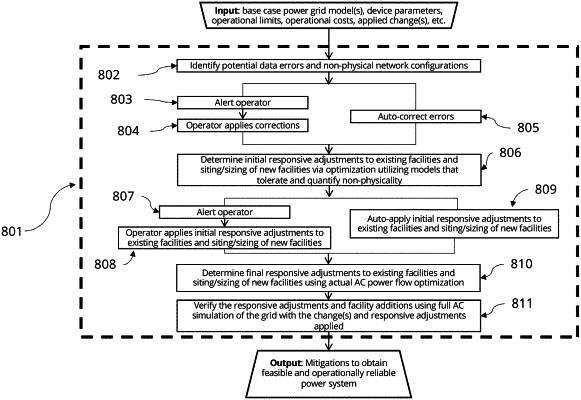| CPC G06F 30/18 (2020.01) [G06F 30/20 (2020.01); G06Q 50/06 (2013.01)] | 18 Claims |

|
1. An automatic process for determining physical mitigation(s) to an original electrical power grid network in response to change(s) in one or more of (i) facility parameters, (ii) network topology, or (iii) additions or retirements of facilities, the method comprising at least the following steps:
(a) receiving information sufficient to determine topology and facility parameters of an altered network and determining the topology and facility parameters of the altered network by applying each of the change(s) (i)-(iii) to the original electrical power grid network;
(b) receiving information that indicates an operating state of the original electrical power grid network;
(c) determining data errors and configurations from the information received in (a) and (b) by (i) determining whether each facility parameter is outside of preselected facility parameter bounds and (ii) determining whether each operating state variable is outside of preselected operating state bounds;
(d) applying corrections to any data errors or configurations determined in (c);
(e) determining initial responsive adjustment(s) to the altered network using model(s) that tolerate at least one operational power limit through use of an augmented objective function wherein the at least one operational power limit comprises at least one of:
(i) facility operational limits, including (i)(a) generators supplying real power above their maximum real power limits or below their minimum real power limits and (i)(b) generators supplying reactive power above their maximum reactive power limits or below their minimum reactive power limits;
(ii) grid control parameters, including conflicting voltage set-points of two or more voltage-controlling facilities; or
(iii) the network topology, including
(iii)(a) transmission lines or transformer windings with unusually high series resistance or reactance that approaches an open circuit;
(iii)(b) large shunt conductances to ground; or (iii)(c) abnormally high or low transformer turn ratios that force bus voltages outside their operational safety ratings; and wherein determining initial responsive adjustment(s) in step (e) further comprises:
(e1) performing a first-pass optimization, using a model that tolerates non-physicality, to identify portion(s) of the altered network for parameter adjustment and/or deployment of additional facilities; and
(e2) performing a second-pass optimization, also using a model that tolerates non-physicality, to refine the identified parameter adjustment(s) and/or newly deployed facilities;
(f) determining final responsive adjustment(s) to the altered network using actual AC power flow optimization; and
(g) verifying the final responsive adjustment(s) using full AC simulation of the altered network with the final responsive adjustment(s) applied.
|